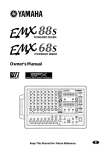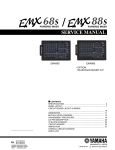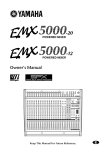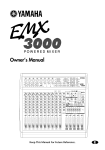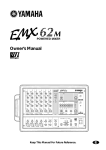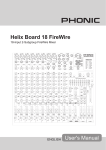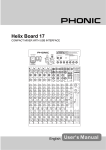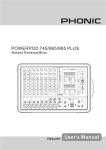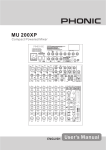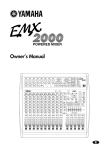Download Yamaha EMX88S EMX68S Owner`s manual
Transcript
Owner’s Manual Keep This Manual For Future Reference. E The Owner’s Manual Revisions E Thank you for purchasing the Yamaha EMX88S/EMX68S Powered Mixer. Parts of the EMX88S, EMX68S owner’s manual have been revised. Please refer to the following revisions rather than the corresponding sections of the original owner’s manual. P.12 P.30 ■ MAIN section ■ Block and Level diagram PA F SPEAKERS OUT MAXIMUM OUTPUT [400W/4Ω] NOMINAL OUTPUT [80W/4Ω] +30dB +20dB +11dB F Level Meter This LED display shows the level of signals received at the MAIN (STEREO) jack (input/output panel 7). Note: The SPEAKERS 1 & 2 jacks (rear panel 1) output the signals received at the MAIN OUT jack via the internal power amplifier. Check the output signal level via the LIMITER indicator (M). ■ MONITOR section K +4dB +10dB 0dB Power Amplifier output section level diagram (bottom right) These plots show the nominal output and maximum output levels of signals received at the SPEAKERS jacks. If the output level is +4dB (Level Meter “0”), the internal power amplifier will deliver 80W into a 4Ω load. If the output level is +11dB (LIMITER indicator lights), the internal amplifier will deliver a maximum of 400W into a 4Ω load. If you are using the BRIDGE jack, the internal power amplifier will deliver 160W into an 8Ω load with a +4dB signal and a maximum of 800W into an 8Ω load with a +11dB signal. K Level Meter This LED display shows the level of signals received at the MONITOR OUT jack (input/output panel 7). Note: The SPEAKERS 1 & 2 jacks (rear panel 1) output the signals received at the MONITOR OUT jack via the internal power amplifier. Check the output signal level via the LIMITER indicator (M). P.13 ■ POWER AMP section M LIMITER indicator If the output level of signals received at the SPEAKERS output jacks (output of the internal power amplifier) reaches maximum, the indicator will light. M Caution: If the LIMITER indicator flashes continuously, the internal power amplifier section is being excessively overloaded and may malfunction. Reduce the output level at the Master controls (EJ) below the level that the indicator flashes only briefly on the highest transient peaks. EMX88S/EMX68S 1 CH INPUT (CH5-6) (CH7-8) CH INPUT (CH3-4) (CH5-6) CH INPUT (CH1-2) (CH1-4) R –50dB –40dB –30dB –20dB –10dB 0dB +10dB +20dB +30dB +40dB LINE [–10dB] L/MONO MIC [–50dB] Super Hi-Z [–30/0dB] Low-Z [–50/–20dB] Hi-Z [–40/–10dB] TAP SW FOOT SW [–10dBV] [–7.8dB] R MIC [–50dB] Lo-Z PAD:OFF [–50dB] Hi-Z PAD:OFF [–40dB] Super Hi-Z [–30dB] Lo-Z PAD:ON [–20dB] Hi-Z PAD:ON [–10dB] BA BA LINE IN [–10dB] PARAMETER PAD (30dB) PAD (30dB) 3-Stage EQ 3-Stage EQ 3-Stage EQ AUX IN [–10dB] 2TR IN [–10dBV] [–16dB] BA BA BA BA BA BA [0dB] [0dB] EFF RTN [–12dB] EFF RTN [–12dB] [–13.8dB] [–13.8dB] SUM [0dB] [0dB] [–16dB] [–16dB] [–6dB] [–6dB] SUM MONITOR [0dB] EFFECT BAL [–16dB] [0dB] [–6dB] EFFECT MONITOR PAN [–16dB] [0dB] [–6dB] EFFECT PAN MONITOR [0dB] 2TR IN LEVEL TAP DIGITAL EFFECT ON [–13.8dB] [–13.8dB] [–16dB] LEVEL [–16dB] [–10dB] LEVEL [–16dB] [–10dB] [–16dB] LEVEL [–10dB] [–16dB] Clip Level [+20dB] R0 L0 2TR IN AUX IN 3-Stage EQ IN [–10dB] SUM PROGRAM [–10dB] R L L/MONO [–10dB] Super Hi-Z PAD:ON [0dB] 2TR IN AUX IN HA BA HA [–10dB] HA [–10dB] Lo Low-Z [–50/–20dB] Hi Hi +15V Mid Mid OFF MAIN L (NON-MUTE) MAIN R (NON-MUTE) MONITOR (NON-MUTE) MAIN L MAIN R EFFECT MONITOR MONITOR [–16dB] EFFECT [–6dB] AUX, 2TR [0dB] MAIN [0dB] INV SUM SUM [0dB] INV SUM SUM [0dB] SUM INV SUM [0dB] SUM INV SUM STAND-BY (CH1-6) (CH1-8) 7-Stage GEQ 1kHz 1kHz ON 250Hz 250Hz R L REC OUT [–10dBV] [–6dB] [–6dB] MASTER [–6dB] [–6dB] MASTER REC OUT [–10dBV] [–7.8dB] 7-Stage GEQ 250Hz Lo 2kHz 2kHz 1kHz Hi 500Hz 500Hz 500Hz Mid 4kHz 4kHz 2kHz Lo DIGITAL EFFECT 125Hz 125Hz 125Hz 8kHz 8kHz 4kHz EMX88S/EMX68S 8kHz 6 7-Stage GEQ PHANTOM BA BA SUM MAIN (L+R)-MON STEREO MONO (BRIDGE) INV MONO STEREO MONO BRIDGE MAIN OUT [+4dB] MONITOR OUT [+4dB] EFFECT OUT [+4dB] LED METER (5 point) [+4dB] [+4dB] [+4dB] BA BA [+4dB] LED METER (5 point) LIMITER LIMITER 1 2 1 2 1 2 1 2 1 2 NOMINAL OUTPUT [80W/4Ω] SPEAKERS OUT MAXIMUM OUTPUT [400W/4Ω] EFF OUT [+4dB] MONITOR [+4dB] YSP ON/OFF YSP ON/OFF MAIN R [+4dB] MAIN L [+4dB] –20dB –10dB 0dB +10dB +20dB +30dB +40dB 2 1 2 1 B [400W/4Ω] BRIDGE [800W/8Ω] A [400W/4Ω] SPEAKERS OUT ■ Block and Level diagram FCC INFORMATION (U.S.A.) 1. IMPORTANT NOTICE: DO NOT MODIFY THIS UNIT! This product, when installed as indicated in the instructions contained in this manual, meets FCC requirements. Modifications not expressly approved by Yamaha may void your authority, granted by the FCC, to use the product. 2. IMPORTANT: When connecting this product to accessories and/or another product use only high quality shielded cables. Cable/s supplied with this product MUST be used. Follow all installation instructions. Failure to follow instructions could void your FCC authorization to use this product in the USA. 3. NOTE: This product has been tested and found to comply with the requirements listed in FCC Regulations, Part 15 for Class “B” digital devices. Compliance with these requirements provides a reasonable level of assurance that your use of this product in a residential environment will not result in harmful interference with other electronic devices. This equipment generates/uses radio frequencies and, if not installed and used according to the instructions found in the users manual, may cause interference harmful to the operation of other electronic devices. Compliance with FCC regulations does not guarantee that interference will not occur in all installations. If this product is found to be the source of interference, which can be determined by turning the unit “OFF” and “ON”, please try to eliminate the problem by using one of the following measures: Relocate either this product or the device that is being affected by the interference. Utilize power outlets that are on different branch (circuit breaker or fuse) circuits or install AC line filter/s. In the case of radio or TV interference, relocate/reorient the antenna. If the antenna lead-in is 300 ohm ribbon lead, change the lead-in to coaxial type cable. If these corrective measures do not produce satisfactory results, please contact the local retailer authorized to distribute this type of product. If you can not locate the appropriate retailer, please contact Yamaha Corporation of America, Electronic Service Division, 6600 Orangethorpe Ave, Buena Park, CA 90620 The above statements apply ONLY to those products distributed by Yamaha Corporation of America or its subsidiaries. • Explanation of Graphical Symbols CAUTION RISK OF ELECTRIC SHOCK DO NOT OPEN CAUTION: TO REDUCE THE RISK OF ELECTRIC SHOCK, DO NOT REMOVE COVER (OR BACK). NO USER-SERVICEABLE PARTS INSIDE. REFER SERVICING TO QUALIFIED SERVICE PERSONNEL. The above warning is located on the rear of the unit. The lightning flash with arrowhead symbol within an equilateral triangle is intended to alert the user to the presence of uninsulated “dangerous voltage” within the product’s enclosure that may be of sufficient magnitude to constitute a risk of electric shock to persons. The exclamation point within an equilateral triangle is intended to alert the user to the presence of important operating and maintenance (servicing) instructions in the literature accompanying the product. WARNING: THIS APPARATUS MUST BE EARTHED IMPORTANT THE WIRES IN THIS MAINS LEAD ARE COLOURED IN ACCORDANCE WITH THE FOLLOWING CODE: GREEN-AND-YELLOW : EARTH BLUE : NEUTRAL BROWN : LIVE As the colours of the wires in the mains lead of this apparatus may not correspond with the coloured markings identifying the terminals in your plug, proceed as follows: The wire which is coloured GREEN and YELLOW must be connected to the terminal in the plug which is marked by the letter E or by the safety earth symbol or coloured GREEN and YELLOW. The wire which is coloured BLUE must be connected to the terminal which is marked with the letter N or coloured BLACK. The wire which is coloured BROWN must be connected to the terminal which is marked with the letter L or coloured RED. * This applies only to products distributed by YAMAHA KEMBLE MUSIC (U.K.) LTD. European Specifications Only This mark indicates a dangerous electrically live terminal. When connecting an external wire to this terminal, it is necessary either to have “a person who have received appropriate guidance on handling” make the connection or to use leads or a cord that have been manufactured in such a way that the connection can be made simply and without problem. 3 Precautions WARNING Installation • Connect this unit’s power cord only to an AC outlet of the type stated in this Owner’s Manual or as marked on the unit. Failure to do so is a fire and electrical shock hazard. • Do not allow water to enter this unit or allow the unit to become wet. Fire or electrical shock may result. • Do not place a container with liquid or small metal objects on top of this unit. Liquid or metal objects inside this unit are a fire and electrical shock hazard. • Do not place heavy objects, including this unit, on top of the power cord. A damaged power cord is a fire and electrical shock hazard. In particular, be careful not to place heavy objects on a power cord covered by a carpet. • Use only the included power cord for this unit. Using other types may be a fire and electrical shock hazard. • The power to this device is not completely shut off even when the power switch is turned off. Locate the device close to the AC outlet so you can easily reach the power plug. Operation • Do not scratch, bend, twist, pull, or heat the power cord. A damaged power cord is a fire and electrical shock hazard. • Do not remove the unit’s cover. You could receive an electrical shock. If you think internal inspection, maintenance, or repair is necessary, contact your dealer. • Do not modify the unit. Doing so is a fire and electrical shock hazard. • If lightning begins to occur, turn off the power switch of the unit as soon as possible, and unplug the power cable plug from the electrical outlet. • If there is a possibility of lightning, do not touch the power cable plug if it is still connected. Doing so may be an electrical shock hazard. In case an abnormality occurs during operation • If the power cord is damaged (i.e., cut or a bare wire is exposed), ask your dealer for a replacement. Using the unit with a damaged power cord is a fire and electrical shock hazard. • Should this unit be dropped or the cabinet be damaged, turn the power switch off, remove the power plug from the AC outlet, and contact your dealer. If you continue using the unit without heeding this instruction, fire or electrical shock may result. • If you notice any abnormality, such as smoke, odor, or noise, or if a foreign object or liquid gets inside the unit, turn it off immediately. Remove the power cord from the AC outlet. Consult your dealer for repair. Using the unit in this condition is a fire and electrical shock hazard. CAUTION Installation • Hold the power cord plug when disconnecting it from an AC outlet. Never pull the cord. A damaged power cord is a potential fire and electrical shock hazard. • Do not touch the power plug with wet hands. Doing so is a potential electrical shock hazard. • This unit has ventilation holes at the rear to prevent the internal temperature rising too high. Do not block them. Blocked ventilation holes are a fire hazard. • When rack-mounting the unit, allow enough free space around the unit for normal ventilation. This should be10 cm at the sides, 15 cm behind, and 25 cm above. For normal ventilation during use, remove the rear of the rack or open a ventilation hole. If the airflow is not adequate, the unit will heat up inside and may cause a fire. PRECAUTIONS FOR OPERATION Connector pin assignments • XLR-type connectors are wired as follows: pin 1: ground, pin 2: hot (+), and pin 3: cold (-). Replacing abrasive parts • The performance of components with moving contacts, such switches, rotary controls, faders, and connectors, deteriorates over time. The rate of deterioration depends on the operating environment and is unavoidable. Consult your dealer about replacing defective components. Operation • Use only speaker cables when connecting speakers to amplifier outputs. Using other types of cables is a fire hazard. Maintenance • Clean the contacts of the phone plug before connecting it to the SPEAKERS jack of this unit. Dirty contacts may generate heat. – FOR CORRECT OPERATION – Influence on cell phone usage • Using a cell phone (mobile telephone) near this unit may induce noise. If noise occurs, use the telephone away from the unit. Volume level setting • Do not set all equalizer controls and faders to maximum. Doing so may cause oscillation depending on the condition of the connected unit and speakers, and may damage the speakers. EMX88S/EMX68S—Owner’s Manual 4 Precautions EMX88S/EMX68S—Owner’s Manual 5 Introduction Thank you for purchasing the Yamaha EMX88S/EMX68S Powered Mixer. The EMX88S/EMX68S has the following features. In order to take full advantage of the EMX88S/EMX68S and enjoy long and trouble-free performance, please read this owner’s manual carefully, and keep it in a safe place for future reference. Features • The EMX88S/EMX68S features eight input channels (EMX88S), six input channels (EMX68S) that support a wide range of audio sources, from microphones to line-level devices. The microphone input for each channel has +15 V phantom power for use with condenser-type microphones. • Two powerful main amps are built-in to deliver 400W + 400W (800W monaural when bridged). According to your needs, the output signal to the power amps can be either stereo [MAIN L-R], [MAIN (L+R)] + monitor [MAIN (L+R) - MON], or [MAIN (L+R)] (bridge connection). ■ Stereo The stereo-mixed main signal will be output from speaker output jacks A and B of the EMX88S/ EMX68S. Either one or two speakers can be connected to each set of speaker jacks. ■ [MAIN (L+R)] + monitor The monaural-mixed main signal will be output from speaker jacks A of the EMX88S/EMX68S, and the monitor signal will be output from speaker jacks B. Either one or two speakers can be connected to each set of speaker jacks. ■ [MAIN (L+R)] (bridge connection) The two power amps will be bridged, and the monaural-mixed main signal will be output from the BRIDGE jack. This allows high-volume output when using only one speaker. • Individual seven-band graphic equalizers are provided to the main and the monitor sections. In this way, you can individually adjust the volume level and frequency response of the main speakers and monitor speakers. • Two limiter circuits are built-in to prevent excessive input levels to the amp. • The 16 built-in effect types are equivalent in quality to those of the acclaimed Yamaha SPX series of multieffect units, and allow a variety of effects to be applied to add reverb or ambience to vocals or instruments. The16 types include TAP DELAY, which lets you easily adjust the delay time. less, and reduced heat generation to 35% or less (in field applications, compared to Yamaha’s previous models), and has lead to a reduction in energy cost and to less-restrictive installation requirements related to heat generation. Contents Introduction........................................................... 5 Features ............................................................... 5 EMX88S/EMX68S Quick Guide ................................. 6 Front and rear panel ................................................. 10 Control panel ...................................................... 10 Input/output panel............................................... 14 Rear panel .......................................................... 16 Installation .......................................................... 16 Connections ............................................................. 17 Basic Operation ........................................................ 20 Connecting microphones and instruments ......... 20 Sending an independent mix to the monitor speakers ................................................................... 20 Using the digital effect ........................................ 20 Example setups ........................................................ 22 As a conference PA system/installed sound system ............................................................ 22 As a band PA...................................................... 23 Installing an optional rack mount kit ......................... 25 Troubleshooting ....................................................... 26 Specifications ........................................................... 27 General specifications ........................................ 27 Input specifications ............................................. 28 Output specifications .......................................... 28 Dimensions ......................................................... 29 Block and Level diagram .................................... 30 • The EMX88S/EMX68S has implemented “EEEngine”, Yamaha’s epochal amp drive technology to create an unrivaled high-efficiency drive. The EEEngine’s energy-saver/low-heat-generation design has reduced power consumption to 50% or EMX88S/EMX68S—Owner’s Manual 6 EMX88S/EMX68S Quick Guide EMX88S/EMX68S Quick Guide Never connect the speakers in the manner shown below. Otherwise, the EMX88S/EMX68S’s builtin power amplifier will be damaged. The following steps (1–5) explain the basic connection and operation of the EMX88S/EMX68S. Also, please read “Front and Rear Panel” and “Basic Operation” following this Quick Guide section to learn more about using the EMX88S/ EMX68S. STEP 1 Connection Connecting speakers Using speaker cables, connect each speaker to the SPEAKERS A 1 jack and to the B 1 jack in the SPEAKERS jack section on the rear panel of the EMX88S/EMX68S. EMX88S (EMX68S) EMX88S (EMX68S) EMX88S (EMX68S) • The diagram above shows an example of connecting two main speakers. Refer to pages 17–18 for other connection examples. • You may connect to either of the two jacks on the speakers. • Be sure to use a cable designed for speaker connection. Setting the power amplifier mode Set the power amp select switch (located on the right corner on the panel) to MAIN L-R. EMX88S (EMX68S) Power amp select switch • This Quick Guide assumes that two main speakers are connected. Refer to pages 13, 17, 18 for other connections and power amp select switch settings. • When the power amp select switch is set to the MAIN L-R position, the stereo L signal will be output from the SPEAKERS A jacks, and the stereo R signal will be output from the SPEAKERS B jacks. EMX88S/EMX68S—Owner’s Manual EMX88S/EMX68S Quick Guide Connecting a microphone Make sure that the power is turned off to the EMX88S/EMX68S. Connect a microphone to the Low-Z jack or MIC jack. 7 Connecting a CD player, MD player, and/or cassette deck Connect a CD player or MD player to the 2TR IN jacks. Refer to the operation manual of the corresponding device for more information on the input and output of the device. EMX88S (EMX68S) EMX88S (EMX68S) Microphone Using a condenser microphone Turn on the PHANTOM switch (located in the upper right corner on the panel). EMX88S (EMX68S) PHANTOM switch CD player Recorder (Cassette, DAT, MD) • To connect a second player, use the LINE jack or HiZ jack. • You cannot use the Hi-Z jack and the Low-Z jack for the same channel at the same time. If a microphone has already been connected to the Low-Z jack of a channel, you cannot connect a player to the Hi-Z jack of the channel. • Connect a recorder to the REC OUT jacks. • Do not connect or disconnect a condenser microphone while the power to the unit is on and the PHANTOM switch has been turned on. EMX88S/EMX68S—Owner’s Manual 8 EMX88S/EMX68S Quick Guide Connecting an electric acoustic guitar or electric bass Connect an electric acoustic guitar or electric bass to the Super Hi-Z jacks. If you wish to connect multiple instruments, make a monaural connection as shown below. EMX88S (EMX68S) EMX88S (EMX68S) Electric-acoustic guitar Electric bass • If you wish to use a guitar signal processor or bass effect unit, connect them to the Hi-Z jack or LINE jack. You cannot use the Hi-Z jack and the Low-Z jack for the same channel at the same time. If a microphone has already been connected to the LowZ jack of a channel, you cannot connect the effect unit to the Hi-Z jack of the channel. Connecting an electronic musical instrument To the EMX88S/EMX68S’s LINE jacks, you can connect an electronic musical instrument such as a synthesizer, drum machine, signal processor connected to an electric guitar, etc. Refer to the diagram below to make a stereo connection from the output jacks (such as L/MONO and R) of an electronic musical instrument to the LINE jacks in stereo. • You can also use the Hi-Z jacks and Super Hi-Z jacks to connect multiple instruments. You cannot use the Hi-Z jack and the Low-Z jack for the same channel at the same time. If a microphone has already been connected to the Low-Z jack of a channel, you cannot connect an instrument to the Hi-Z jack of the channel. STEP 2 Power on 1 Turn on the power to all external devices connected to the EMX88S/EMX68S. 2 Make sure that the MASTER controls in the MONITOR section and the MAIN section are set to “0,” then press the POWER switch on the EMX88S/EMX68S to turn on the power. EMX88S (EMX68S) EMX88S (EMX68S) Synthesizer, Drum machine, Guitar processor EMX88S/EMX68S—Owner’s Manual • Be sure to follow the power up sequence specified above to prevent the speakers from being damaged. • To correct the low range, turn on the YAMAHA SPEAKER PROCESSING switch in the upper right corner of the panel. EMX88S/EMX68S Quick Guide STEP 3 Sound output Set the MASTER control in the MAIN section to “√ ,” then while playing an instrument connected to a channel to be checked (or while speaking to a connected microphone), adjust the LEVEL control of the corresponding channel so that the 0 LED of the peak level indicator in the MAIN section will light up momentarily. • Do not press the PAD switch if sound is input from the microphone. Otherwise, press the PAD switch on. • If you are using one of the speakers as a monitor speaker, use the MASTER control of the MONITOR section to adjust its volume. 9 STEP 4 Applying built-in effects 1 Turn on the ON switch in the DIGITAL EFFECT section. The ON switch indicator lights up. 2 Using the Program selector, select one of 16 effect types. 3 Adjust the amount of effect applied by using the EFFECT control of the target channel and the EFFECT RTN control in the MAIN section. EMX88S (EMX68S) EMX88S (EMX68S) STEP 5 Power off • Note that if the LIMITER indicator stays lit for a long time, the built-in amplifier and speakers may be damaged. 1 Press the POWER switch of the EMX88S/EMX68S to turn off the power to the unit. 2 Turn off the power to all connected devices. • Be sure to follow the power off sequence specified above to prevent the speakers from being damaged. • Set the MASTER controls in the MAIN section and the MONITOR section to “0” for use next time (so that a loud noise will not sound the next time you turn on the power to the unit). EMX88S/EMX68S—Owner’s Manual 10 Front and rear panel Front and rear panel Control panel ■ Channel section Use these controls to adjust factors such as the equalization, (frequency response), volume, effect and monitor output level for the input signal to each channel. 1 2 MONITOR control For each channel, this controls the amount of signal that is sent to the MONITOR bus. The signal of the MONITOR bus is sent to the MONITOR jacks (input/output panel 7). Note: The signal is sent to the MONITOR bus from a location before the level control (5) of each channel. This means that it will not be affected by the setting of the Level control. 3 EFFECT control 2 3 4 5 6 1 Equalizer controls (HIGH, MID, LOW) This is a 3-band equalizer that adjusts the high frequency range, mid frequency range, and low frequency range of each channel. Response is flat when the knobs are in the “▼” position. Rotating it toward the right will boost the corresponding frequency band, and rotating it toward the left will cut it. The base frequency (or center frequency), range of boost or cut, and equalizer type of each band are as follows. HIGH: 10 kHz ±15 dB shelving type MID: 2.5 kHz ±15 dB peaking type LOW: 100 Hz ±15 dB shelving type EMX88S/EMX68S—Owner’s Manual For each channel, this controls the amount of signal that is sent to the EFFECT bus. The signal of the EFFECT bus is sent to the builtin digital effect, and to the EFFECT OUT jacks (input/output panel 4). Note: The signal is sent to the EFFECT bus from a location after the level control (5) of each channel. This means that the amount of signal that is sent to the EFFECT bus will be affected not only by the setting of the effect control, but also by the setting of the level control. 4 PAN control (BAL/PAN control for CH7/8 (EMX88S), CH5/6 (EMX68S)) This knob adjusts the stereo image (L/R) for each channel. Adjust for equal volume on left and right with a sound source input to the CH7 and 8 (EMX88S), CH5 and 6 (EMX68S) LINE connectors (L/R). 5 LEVEL control This adjusts the output level for each channel. 6 PAD switch (1–6 (EMX88S) only, 1–4 (EMX68S) only) This switch attenuates the input signal by 30 dB. When connecting a line level device to channels 1–6 (EMX88S), 1–4 (EMX68S), or if the mic input is distorted, turn this switch on (the pressed-in position). Control panel ■ DIGITAL EFFECT section This section allows you to turn the built-in digital effect on/off and to select the effect type. 11 val between the last two presses will be set as the delay time. The specified time will be remembered even if the power is turned off. The LED beside the switch will blink in synchronization with the delay time only when the effect type is TAP DELAY. ■ MAIN section This section allows you to adjust the tone and volume of the stereo (MAIN L, R) bus, the mix level of the built-in effect, and the mix level of the external input. A 7 F 8 E 9 0 B 7 PROGRAM selector This knob selects the effect type for the internal digital effect. 8 PARAMETER control This knob adjusts the parameter of the internal digital effect. * If TAP DELAY is selected by the PROGRAM selector, this adjusts the amount of feedback. 9 DIGITAL EFFECT ON switch Use this switch to turn the digital effect on and off. When this switch is on, the effect bus signal processed with the built-in digital effect is sent to the stereo (MAIN L, R) bus and MONITOR bus. The mix level of the effect sound is adjusted with the EFFECT RTN control in the MAIN and MONITOR sections. The LED beside the switch will light when the effect is on. D C A Graphic equalizer The EMX88S/EMX68S has a 7-band graphic equalizer for adjusting the frequency response of the stereo (MAIN L, R) bus signal. This allows you to cut or boost each frequency band by a maximum of ±12dB. These graphic equalizer settings affect both the stereo (MAIN L, R) bus signal output to the speakers and the line level signal output from the MAIN (STEREO) jack (input/output panel 7). B EFFECT RTN control Use this control to adjust the effect signal sent to the stereo (MAIN L, R) bus from the built-in digital effect. C AUX IN control This control adjusts the amount of signal that is sent from the AUX IN jack to the stereo (MAIN L, R) bus. 0 TAP switch Only if the PROGRAM selector has selected TAP DELAY as the internal effect type, you can press this switch to set the desired delay time. Press the TAP switch several times, and the inter- EMX88S/EMX68S—Owner’s Manual 12 Front and rear panel D 2TR IN control This adjusts the amount of signal that is sent from the 2TR IN jacks to the stereo (MAIN L, R) bus. These graphic equalizer settings affect both the MONITOR bus signal output to the speakers and the line level signal sent from MONITOR jack signal (input/output panel 7). H EFFECT RTN control E MASTER control This control adjusts the stereo (MAIN L, R) bus signal output level. This setting is output to the SPEAKERS A, B, BRIDGE jacks and the MAIN (STEREO) jack (input/output panel 7) on the rear panel and appears in the stereo (MAIN L, R) bus signal. F Peak level indicator This indicator allows you to monitor the level of the signal which is output from the MAIN (STEREO) jack (input/output panel 7). Note: To avoid distortion, adjust the MASTER control (E) so that the 0 indicator lights occasionally. This control adjusts the effect signal level sent to the MONITOR bus from the built-in digital effect. I 2TR IN control This control adjusts the amount of signal that is sent from the 2TR IN jacks to the MONITOR bus. J MASTER control This control adjusts the MONITOR bus signal output level. This setting is output to both the front and rear panel MONITOR jacks and appears in the MONITOR bus signal. K Peak level indicator This indicator allows you to monitor the level of the signal which is output from the MONITOR jack (input/output panel 7). ■ MONITOR section This section allows you to adjust the tone and volume of the MONITOR bus, and specify the mix level of the built-in digital effect. Note: To avoid distortion, adjust the MASTER control (J) so that the 0 indicator lights occasionally. G ■ PHANTOM switch, indicator K L H J L PHANTOM ON, OFF switch I G Graphic equalizer The EMX88S/EMX68S has a 7-band graphic equalizer for adjusting the frequency response of the MONITOR bus signal. This allows you to cut or boost each frequency band by a maximum of ±12dB. You can use these sliders to reduce the level of frequency bands at which feedback easily occurs. Frequency response is flat when a slider is in the center position. Moving a slider in the positive direction will boost, and in the negative direction will cut. EMX88S/EMX68S—Owner’s Manual This switch turns the phantom power supply on/ off for the Low-Z XLR type input jacks of channels 1–6 (EMX88S), 1–4 (EMX68S). Turn this switch off if you do not use it. Control panel ■ POWER AMP section Here you can select the operating mode of the power amp. You can also check the operation of the limiter circuit. M 13 ■ YAMAHA SPEAKER PROCESSING O ON/OFF switch This switch enables you to compensate the low range of the speakers. The low range balance when this switch is on varies depending on the speakers. First, check the low range balance by auditioning the resultant sound, then set this switch to on or off. N O M LIMITER indicator This indicator lights up when the level of the signal output from the power amp section reaches the maximum and the limiter is activated. Adjust appropriate control so that the indicator lights up for only a short while when the signal reaches the maximum level. Note: The indicator lights up or flashes for a longer duration if the power amp section is significantly overloaded, which could result in malfunction. Avoid such a situation. N Power amp select switch Select one of the following settings to specify the signals to be routed to the corresponding jacks according to the speaker connection at the SPEAKERS jacks 1 on the rear panel. • MAIN L-R The stereo (MAIN L, R) bus signals are output from the SPEAKERS A 1, 2 jacks and the SPEAKERS B 1, 2 jacks. The final level of these signals is adjusted by the MAIN MASTER control. • MAIN (L+R)-MON The MONITOR bus signals are output from the SPEAKERS B 1, 2 jacks, and a monaural signal that is a mix of the stereo (MAIN L, R) bus signals is output from the SPEAKERS A 1, 2 jacks. The final level of these signals is adjusted by the MAIN MASTER control and the MONITOR MASTER control. • MONO (BRIDGE) The monaural signal that is a mix of the stereo (MAIN L, R) bus is output from the BRIDGE jack. The final level of this signal is adjusted by the MAIN MASTER control. Set the switch to this position when you connect only a single speaker for high-volume amplification. ■ STAND-BY P ON/OFF switch This switch mutes (silences) the input signals from channels 1–8 (EMX88S) or channels 1–6 (EMX68S). The indicator will blink when this switch is on. The on/off setting of this switch does not affect the signal from the AUX IN jacks or 2TR IN jacks. P ■ Power switch and indicator Q Q Power ON/OFF switch and indicator This switch turns the power of the EMX88S/ EMX68S on/off. When the switch is turned on, the indicator lights up. Note: Before turning the EMX88S/EMX68S on/ off, turn down the MASTER controls of the MONITOR and MAIN section. EMX88S/EMX68S—Owner’s Manual 14 Front and rear panel Input/output panel 2 4 1 3 1 Channel input jacks (Hi-Z, Low-Z) Pin 1: ground Pin 2: hot (+) Pin 3: cold (–) Hi-Z jacks (TRS phone jacks) Sleeve: ground Tip: hot (+) Ring: cold (–) S + - GND R T GND - + Note: It is not possible to simultaneously use both the Hi-Z and Low-Z inputs of a given channel. For each channel, use only one of the inputs as appropriate for the input source. Phantom power is switched on/off in simultaneously for channels 1–8 (EMX88S), 1–6 (EMX68S). For this reason, devices which do not require phantom power must be connected to the Hi-Z or LINE jacks if the PHANTOM switch (control panel L) is on. EMX88S/EMX68S—Owner’s Manual 6 7 2 Super Hi-Z jacks 1–6 (EMX88S), 1–4 (EMX68S) These are the input jacks for channels 1–6 (EMX88S), 1–4 (EMX68S). By using the PAD switches (control panel 6) you can connect any of the jacks to a wide range of sources from mics to line level devices (synthesizers or rhythm boxes etc.). The Low-Z jacks can provide +15 V phantom power, allowing you to use condenser microphones. Both Hi-Z and Low-Z are balanced, and are compatible with microphones of output impedance 50–600Ω or line level devices of 600Ω. The nominal input level is from –40 dB to –10 dB for the Hi-Z jacks, and from –50 dB to –20 dB for the Low-Z jacks. Pin connections for the Hi-Z and Low-Z jacks are as follows. Low-Z jacks (XLR type) 5 These two phone jacks are the input connectors for input channel 5–6 (EMX88S), 3–4 (EMX68S). They are unbalanced, can be used simultaneously, and their high input impedance makes them ideal for use with instruments such as electric-acoustic guitar and electric bass. They can also be used with line-level sources, such as synthesizers and drum machines. 3 Channel input jacks (MIC/LINE) 7–8 (EMX88S), 5–5 (EMX68S) These are the input jacks for channels 7–8 (EMX88S), 5–6 (EMX68S). Connect microphones to the MIC jacks. Connect line-level devices, such as synthesizers to LINE L (MONO)/R jacks if the devices are stereo sound sources. Use the LINE L (MONO) jack if the devices are monaural sound sources. The MIC jacks can provide +15 V phantom power, allowing you to use condenser microphones. The MIC jacks are balanced, and are compatible with microphones of output impedance 50– 600Ω. The LINE jacks are unbalanced, and are compatible with line level devices of 600Ω output impedance. Nominal input level is –50 dB for the MIC jacks and –10 dB for the LINE jacks. Note: The MIC and LINE inputs for channel 7 (EMX88S), 5 (EMX68S) can be used simultaneously but their levels cannot be adjusted separately (Same for channel 8 (EMX88S), 6 (EMX68S).) Input/output panel 4 EFFECT OUT jack The input of an external effect such as a delay or echo can be connected to this jack. The signal adjusted by the EFFECT control of each channel will be sent to the EFFECT bus, its level adjusted by the EFFECT OUT control, and output from this jack. The nominal output level and impedance are +4 dB/10 kΩ. 5 FOOT SW jack You can connect a Yamaha FC5 foot switch (sold separately) to this jack and use it to turn the built-in digital effect on and off. The Digital Effect ON switch on the front panel must always be set to ON in order to use the foot switch. 6 AUX IN/2TR IN-INPUT TO MAIN jacks These are input jacks that allow the signal from an external device to be added to the MAIN output. • AUX IN jacks: Connect these jacks to the output jacks of an external effects processor. If the effects processor has a stereo output, connect it to the AUX IN L (MONO) and R jacks. If it has monaural output, use the AUX IN L (MONO) jack. Signal input to these jacks is sent to the stereo (MAIN L, R) bus. 15 7 REC OUT/MAIN (STEREO)/MONITOROUTPUT jacks These are output jacks which send line level signals from the EMX88S/EMX68S to external devices. A stereo recording device such as a cassette recorder or MD recorder can be connected to the REC OUT jacks, and a playback device such a power amp can be connected to the MONITOR and MAIN (STEREO) jacks. The signals sent from each jack are as follows. • REC OUT jacks: The stereo (MAIN L, R) bus signal before it has passed through the MASTER control and graphic equalizer • MONITOR jack: The MONITOR bus signal which has passed through the MONITOR MASTER control and graphic equalizer • MAIN (STEREO) jack: The stereo (MAIN L, R) bus signal which has passed through the MAIN MASTER control and graphic equalizer The nominal output level and impedance are –10 dBV/10 kΩ for the REC OUT jacks, and +4 dB/10 kΩ for the MONITOR/MAIN (STEREO) jacks. • 2TR IN jacks: Use these jacks to connect a stereo device, such as a cassette player or a CD player. The signals input to these jacks is sent to the stereo (MAIN L, R) bus. The nominal input level and impedance are –10 dB/ 600Ω for the AUX IN jack, and –10 dBV/600Ω for the 2TR IN jacks. EMX88S/EMX68S—Owner’s Manual 16 Front and rear panel Rear panel 2 1 1 Speaker output jacks (SPEAKERS) 2 AC IN socket Connect speakers here. The EMX88S/EMX68S has two internal power amps. There are three ways in which speakers can be connected to the EMX88S/EMX68S. Connect the included power cord to this socket. Connect the plug of the power cord to an AC outlet that meets the requirements stated in the specifications in this document. • Two-channel connection • Two-channel parallel connection • Bridge connection At this time, use the power amp select switch N on the control panel to select a signal sent to the correct jacks. Refer to the “Connections” section on the next page. Installation The EMX88S/EMX68S uses a forced cooling system with intake on the bottom of the rear panel and exhaust on the top of the rear panel to avoid blocking the heated air flow. NO 15cm or less Front NO Exhaust Front Intake EMX88S/EMX68S—Owner’s Manual Connections 17 Connections When connecting various devices, make sure the cables and plugs have the correct rating. Be sure to use cables designed for the purpose when you connect speakers to speaker jacks. ■ Connecting main speakers There are three ways in which speakers can be connected to the EMX88S/EMX68S. The speaker impedance requirement varies depending on how you connect the speakers. Refer to the diagrams below to make sure the speaker impedance will not be lower than the specified value. ■ When the power amp select switch is set to MAIN L-R or MAIN (L+R)-MON: • 2-channel connections Connect either one or two speakers each to jacks A and jacks B. If the power amp select switch is set to MAIN L-R, the signals of the MAIN L and MAIN R buses will be output respectively to the speakers connected to the A and B jacks. If the power amp select switch is set to MAIN (L+R)-MON, the summed signals of the MAIN L bus + R bus and the signal of the MONITOR bus will be output respectively to jacks A and B. For either setting of the switch, use speakers with an impedance in the range of 4–8 ohms if you are connecting only one speaker to each set of outputs. A maximum output of 400W + 400W will be obtained when 4ohm speakers are used. Power amp select switch Not used or 4Ω–8Ω 4Ω–8Ω • 2-channel parallel connections If you connect two speakers to each set of outputs, use speakers with an impedance in the range of 8–16 ohms. A maximum output of 400W + 400W will be obtained when 8-ohm speakers are used. Power amp select switch or Not used 8Ω–16Ω 8Ω–16Ω 8Ω–16Ω 8Ω–16Ω EMX88S/EMX68S—Owner’s Manual 18 Connections ■ When the power amp select switch is set to MAIN (L+R) BRIDGE: • Bridge connection Connect only one 8–16 ohm speaker to the BRIDGE jack. The speaker will output the combined signal of the MAIN L bus + R bus. A maximum output of 800 W will be obtained when an 8-ohm speaker is used. Power amp select switch Not used Not used 8Ω–16Ω Caution: When using two-channel connection or two-channel parallel connection, do not connect a speaker to the BRIDGE jack. When using a bridge connection, do not connect a speaker to either the A or B jacks. The BRIDGE jack has a protective cap that prevents a speaker from being accidentally connected to it when you are using two-channel or two-channel parallel connections. Remove this protective cap only when making a bridge connection. ■ Connecting a monitor speaker You can connect a powered speaker to the MONITOR jack. VOL Powered monitor EMX88S/EMX68S—Owner’s Manual Connections 19 ■ Example connections Synthesizer, Drum Box Cassette Deck CD Player Microphone Foot switch (YAMAHA FC5) 88 Effect Processor Main Speakers Electric bass Electric-acoustic guitar Power amp * Speakers normally connect to the jacks on the rear panel. When more speaker outputs are needed, use the MAIN (STEREO) jacks are for stereo output and the MONITOR jack is for monaural output. Monitor Speakers EMX88S/EMX68S—Owner’s Manual 20 Basic Operation Basic Operation This section explains basic operation of the EMX88S/EMX68S. Connecting microphones and instruments Sending an independent mix to the monitor speakers 1 Before connecting mics or instruments, 1 Set the MONITOR section MASTER con- make sure that the power of all equipment (where applicable) is turned off. Also make sure that the level controls of each channel of the EMX88S/EMX68S and the MASTER control of the MAIN section are turned down. 2 Connect cables to your mics and instruments, and insert the other end of the cable firmly into the appropriate Low-Z/ Hi-Z jack or the MIC/LINE jack. Note: When connecting a line level device to channels 1–6 (EMX88S), 1–4 (EMX68S), turn on the PAD switch. You cannot use a channel’s Low-Z and Hi-Z jacks, and MIC and LINE jacks at the same time. 3 Turn the power on in the order of peripheral devices ➞ EMX88S/EMX68S. Note: When turning the power off, reverse this sequence. 4 Set the MAIN section MASTER control to √” position. the “√ Adjusts the stereo image of each channel using the PAN or BAL/PAN controls. (Adjust the balance between the left and right volume levels of the sound sources connected to the LINE connectors L/R.) 5 While speaking into the mic (while playing the instrument), adjust the channel LEVEL control so that the 0 LED of the MAIN section peak level meter lights occasionally. 6 If you wish to adjust the tone of each channel, rotate the equalizer controls as desired. 7 Use the MAIN section graphic equalizer and MASTER control to adjust the overall volume and tone. EMX88S/EMX68S—Owner’s Manual √” position. trol to the “√ 2 Adjust the MONITOR control to increase the level of the channel you want to hear from the monitor speaker, and also adjust so that the peak level meter 0 LED of the monitor section lights up occasionally. Note: The MONITOR controls are not affected by the level settings of each channel. This allows you to create a mix that is independent of the MAIN section. 3 Use the graphic equalizers and MASTER controls of the MAIN/MONITOR sections to adjust the overall volume and tone. Using the digital effect The EMX88S/EMX68S has a built-in digital effect, allowing reverberation or ambiance to be added to vocals or instrumental sounds. 1 Connect a mic or instrument to the desired channels, and adjust the volume and tone. 2 Press the DIGITAL EFFECT ON switch of the DIGITAL EFFECT section. 3 Use the PROGRAM selector of the DIGITAL EFFECT section to select the effect type. 4 Raise the EFFECT control of the channels to which you wish to apply the digital effect. 5 Use the MAIN/MONITOR section EFFECT RTN control to adjust the level of the sound processed by the effect. Note: If the effect sound is distorted even if the EFFECT RTN is turned all the way down, lower the EFFECT controls of each channel. Using the digital effect 21 Controllable parameter No. Program Description Parameter Variable range REVERB HALL Reverberation simulating a spacious expanse such as a concert hall. Reverb time 0.3–10.0s REVERB ROOM Reverberation simulating the acoustics of a small room. Reverb time 0.3–3.2s REVERB PLATE Simulation of a plate reverb device. Produces a hard-sounding reverberation. Reverb time 0.3–10.0s REVERB VOCAL 1 REVERB VOCAL 2 Ideal reverb for vocals. Reverb time 0.3–10.0s VOCAL ECHO 1 VOCAL ECHO 2 Ideal echo for vocals. Delay time 0–800ms DELAY 1 DELAY 2 Delay effect that delays the signal. Delay time 0–800ms An effect produced by modifying the early reflections. It lets you add depth to the sound, or create echo-like effects. Room size 0.1–10.0 EARLY REF. GATE REVERB An effect produced by cutting the reverberation. Room size 0.1–5.0 VOCAL DOUBLER Produces an effect as though two people were singing. Pitch fine 0–50 SYMPHONIC Gives a richly layered depth to the sound. Depth 0–100% FLANGE Adds a sense of pitch to the tone. Effective on sounds that contain numerous overtones. Modulation frequency 0.05–4.00Hz DISTORTION The well-known effect used to distort the sound. Drive 0–100 Feedback gain 0–99% TAP DELAY This effect sets the delay time to the interval at which you actually press the switch. The amount of feedback can be adjusted by the PARAMETER control. The LED will blink in synchronization with the delay time. Delay time 100ms (600bpm)– 2690ms (22.3bpm)* * The LED can not blink any faster than an interval of 256 ms (234.3 bpm). EMX88S/EMX68S—Owner’s Manual 22 Example setups Example setups This section provides some ways in which the EMX88S/EMX68S can be used, and explains connections and operation. As a conference PA system/installed sound system This example shows the EMX88S/EMX68S used as a conference PA system or sound system. A sound mix different from that of the main speakers can be sent to the powered monitor speakers connected to the MONITOR jack. Main Speakers Set to MAIN L-R SPEAKERS B1/2 Powered monitor Main Speakers VOL SPEAKERS A1/2 Microphone CD Player Connections • Connect mics to channel input jacks. • If you wish to use an external device such as a CD player or LD player, connect the outputs of the device to the 2TR IN jacks of the EMX88S/ EMX68S. Note: You can connect a stereo playback device, such as a CD player or an LD player, to channels 7–8 (EMX88S), 5–6 (EMX68S) LINE inputs. The MIC and LINE inputs of channel 7 can be used simultaneously but their levels cannot be separately adjusted. (Same for channel 8 (EMX88S), 6 (EMX68S)) • If you wish to record the audio from the mics to a cassette deck, connect the REC OUT jacks of the EMX88S/EMX68S to the input jacks of the cassette deck. EMX88S/EMX68S—Owner’s Manual Cassette Deck • Connect the main speakers to the SPEAKERS B1 or 2 jacks and the SPEAKERS A1 or 2 jacks. • Connect the powered monitor speakers to the MONITOR jack. Playing back a CD player 1 Turn the power on in the order of peripheral devices ➞ EMX88S/EMX68S. 2 Adjust the MASTER control of the MAIN √” position. section to the “√ 3 Start playback on the CD player, and use the MAIN section 2TR IN control to adjust the level so that the 0 LED of the MAIN section peak level meter does not light. As a band PA 23 As a band PA Here is an example of using the EMX88S/EMX68S as a small PA for a band. In this example, an external effect such as delay or reverb is also being used. Connections Set to MAIN (L+R) - MON Main Speakers SPEAKERS A 1 2 SPEAKERS B 1 2 88 Effect Processor Monitor Speakers Footswitch (YAMAHA FC5) (TAP) Microphone Electric bass *1 Footswitch (YAMAHA FC5) (EFFECT ON/OFF) Electric-acoustic guitar Synthesizer *1. Although this example shows an external effects processor and footswitch, which is used to turn on and off the built-in digital effects processor, connected to the EMX88S/EMX68S, in practice, only one effects processor, internal or external, will be used at a time, so the footswitch is not required when using external effects. EMX88S/EMX68S—Owner’s Manual 24 Example setups • Connect mics or instruments, such as keyboards, to the channel input jacks. Using an external effect • Connect the main speakers to the SPEAKERS A, B 1/2 jacks and the monitor speakers. √” position. trol to the “√ • If you will be using an external effect such as delay or reverb, connect the EMX88S/EMX68S’s EFFECT OUT jack to the input jack of the external effect, and connect the output jack of the external effect to the EMX88S/EMX68S’s AUX IN jack. Note: If you are using an external effect, we recommend that you turn down the EFFECT RTN controls of the MAIN and MONITOR sections. If the external effect has a stereo output, it is possible to connect its output jacks to the LINE jacks. However in this case, be sure that the EFFECT controls are turned all the way down for the channels into which the effect sound is being input. If the EFFECT controls are raised, feedback will occur, and your speakers may be damaged. EMX88S/EMX68S—Owner’s Manual 1 Set the EFFECT section EFFECT OUT con2 Raise the EFFECT controls for the channels to which you want the external effect to be applied. 3 Adjust the input level of the external effect so that the sound is not distorted at the input of the external effect. 4 Use the MAIN section AUX IN control to adjust the level of the sound processed by the effect. Installing an optional rack mount kit 25 Installing an optional rack mount kit You can rack-mount the EMX88S/EMX68S using an optional rack mount kit (RK-88). Rack mount kit RK-88 Installing the rack mount bracket 1 Remove the carrying handle by loosening and removing four screws. • Bracket × 2 • Screw × 6 Before you rack-mount the EMX88S/EMX68S, make sure that sufficient ventilation will be maintained. (Never install the unit in a sealed rack.) If you are going to install multiple devices including the unit in a rack, keep a 1U space or more between the devices. Use a blank panel with holes for ventilation if you wish to insert a panel between the devices. You will need a 7U space to install the rack mount. After installation, the unit will project 62 mm from the front surface of the rack. 2 Attach one of the rack mount brackets to the side of the EMX88S/EMX68S using three included screws. 62 3 Attach the other rack mount bracket in the same way. EMX88S/EMX68S—Owner’s Manual 26 Troubleshooting Troubleshooting The following table describes the possible malfunctions of this device, and the appropriate actions to be taken in each case. Problem Cause Action Please wait. When the device cools off, normal operation will resume automatically. However, please check the following three points to prevent The load on the amplifier of this device the problem from recurring. • If the level setting is excessive, lower it to the was too great, and the protection cirnominal level. You can refer to the peak level cuit for the amplifier has operated. indicators of the main section when doing so. Possible reasons for the excessive load The POWER • If the device is not ventilated sufficiently, refer to are an excessive level setting in the indicator is lit. the cautions given at the beginning of this manchannel control section or main section, Sound is no ual and take appropriate measures to insure insufficient ventilation, or insufficient longer outadequate ventilation. load impedance of the connected speakput from the • If the load impedance (including a short) is too ers. speakers. low, refer to the chapter on connections (page 15) and change the connections so that the impedance is correct. Connections between devices have come loose. Inspect the connections, and correct any faulty connections. Other The device may have malfunctioned. Please contact your dealer. Other Powered Mixer Q&A Q: The built-in effect is not effective. A: The ON switch in the DIGITAL EFFECT section may not be turned on. Or, you have adjusted the EFFECT control in the Channel section or the EFFECT RTN control in the MAIN section. Q: The monitoring sound from the speakers is not powerful enough relative to the level of the input sound. A: The equalizer LOW control for each channel may be set to negative values. Q: The signal is sent from the EFFECT OUT jack to the connected effect processor. Then the effect sound is returned to the AUX IN jack. However, no signal is input to the mixer. A: The AUX IN control in the MAIN section may not be rotated to right. Q: An external powered speaker is connected to the MONITOR-OUTPUT jack. However, the signal is not sent to the speaker even when the MASTER control in the MONITOR section is turned. A: The MONITOR controls for input channels may not have been adjusted. Q: Can the Low-Z jack and the Hi-Z jack be used at the same time? A: You cannot use the Low-Z jack and the Hi-Z jack for the same channel at the same time. Q: Can a single speaker be connected to the mixer? A: Yes. Use a speaker with an impedance of 4-8 ohms. EMX88S/EMX68S—Owner’s Manual Specifications 27 Specifications ■ General specifications Maximum output power MAIN L, R: 400 W+400 W/4Ω @0.5% THD at 1 kHz, 270 W+270 W/8Ω @0.5% THD at 1 kHz MAIN BRIDGE: 800 W/8Ω @0.5% THD at 1 kHz Frequency response 20 Hz–20 kHz +1 dB, –3 dB @1 W output into 8Ω (SPEAKERS OUT) 20 Hz–20 kHz +1 dB, –3 dB @+4 dB output into 10 kΩ (MAIN OUT, MONITOR OUT, EFFECT OUT) Total harmonic distortion Less than 0.5% @20 Hz–20 kHz, 200 W output into 4Ω (SPEAKERS OUT) Less than 0.3% @20 Hz–20 kHz, +14 dB output into 10 kΩ (MAIN OUT, MONITOR OUT, EFFECT OUT) –124 dB equivalent input noise, –65 dB residual output noise (SPEAKERS OUT) –88 dB residual output noise (MAIN OUT, MONITOR OUT) Hum & noise (Average, Rs=150Ω) (with 20 Hz–20 kHz BPF) –79 dB (MAIN OUT) Master level control: nominal level, All channel level controls: minimum –75 dB (MONITOR OUT) Master level control: nominal level, All channel level controls: minimum –69 dB (MAIN OUT) Master level control: nominal level, 1 channel level control: nominal level –84 dB (EFFECT OUT) All channel level controls: minimum –64 dB (EFFECT OUT) 1 channel level control: nominal level Maximum voltage gain 86 dB CH IN (Lo-Z) to SPEAKERS OUT 66 dB CH IN (Lo-Z) to MAIN OUT, MONITOR OUT 66 dB CH IN (Lo-Z) to EFFECT OUT 48 dB CH IN (Lo-Z) to REC OUT 56 dB CH IN (Hi-Z) to MAIN OUT, MONITOR OUT 46 dB CH IN (Super Hi-Z) to MAIN OUT 26 dB AUX IN to MAIN OUT 24 dB 2TR IN to MAIN OUT 66 dB MIC IN to MAIN OUT 26 dB LINE IN to MAIN OUT Crosstalk at 1 kHz 65 dB adjacent input, 65 dB input to output Input channel equalization ±15 dB Maximum HIGH 10 kHz shelving MID 2.5 kHz peaking LOW 100 Hz shelving * Turn over/roll-off frequency of shelving: 3 dB below maximum variable level. Meters 5 POINTS LED METER (MAIN OUT L/R, MONITOR OUT) Graphic equalizer 7 bands (125, 250, 500, 1k, 2k, 4k, 8k Hz) ±12 dB Maximum (MAIN OUT, MONITOR OUT) Internal digital effect 16 programs, parameter control, tap delay control Phantom power +15 V (balanced input) Limiter Comp. : THD≥0.5% (SPEAKERS OUT) LIMIT indicators Turns on. : THD≥0.5% (SPEAKERS OUT) Protection circuit (Power amp) POWER switch on/off mute, DC detection, TEMP (heatsink temp. ≥90°C) Fan circuit stop — low speed (50°C) — variable — high speed (70°C) Foot switch (FC5) DIGITAL EFFECT MUTE : on/off, Tap delay Optional accessories RK-88, FC5 Power requirement/ Power consumption USA and Canada Europe Other Dimensions (WxHxD) 482×305×328 mm Weight 15.5 kg Supplied accessories AC power cord, Owner’s Manual 120 V AC 60 Hz/300W 230 V AC 50 Hz/350W 240 V AC 50 Hz/350W EMX88S/EMX68S—Owner’s Manual 28 Specifications ■ Input specifications Input level Input connectors Actual load PAD impedance CH INPUT (Low-Z) (CH1–4/1–6) OFF CH INPUT (Hi-Z) (CH1–2/1–4) OFF CH INPUT (Super Hi-Z) (CH3–4/5–6) OFF Nominal impedance Sensitivity*1 Max. before clipping Nominal level 50–600Ω Mics –62 dB (0.616 mV) –50 dB (2.45 mV) 3 kΩ ON –20 dB (77.5 mV) XLR-3-31 600Ω Lines –32 dB (19.5 mV) –20 dB (77.5 mV) +10 dB (2.45 V) type*2 50–600Ω Mics –52 dB (1.95 mV) –40 dB (7.75 mV) –10 dB (245 mV) Phone jack 600Ω Lines –22 dB (61.6 mV) –10 dB (245 mV) +20 dB (7.75 V) (TRS)*2 –42 dB (6.16 mV) –30 dB (24.5 mV) 0 dB (775 mV) –12 dB (195 mV) 0 dB (775 mV) +10 dB (3.16 V) 10 kΩ ON Connector type 470 kΩ Phone jack*3 1kΩ ON 50–600Ω Mics –62 dB (0.616 mV) –50 dB (2.45 mV) –20 dB (77.5 mV) XLR-3-31 type*2 MIC INPUT 3 kΩ LINE INPUT (L, R) 10 kΩ 600Ω Line –22 dB (61.6 mV) –10 dB (245 mV) +20 dB (7.75 V) Phone jack*3 AUX IN (L, R) 10 kΩ 600Ω Line –22 dB (61.6 mV) –10 dB (245 mV) +20 dB (7.75 V) Phone jack*3 2TR IN (L, R) 10 kΩ 600Ω Line –22 dBV (79.4 mV) –10 dBV (316 mV) +17.8 dBV (7.76 V) Phono jack *1. Sensitivity is the lowest level that can produce an output of +4 dB (1.23 V) or the nominal output level when the unit is set at maximum gain. (All level controls are at maximum position.) *2. Balanced. *3. Unbalanced. • 0 dB=0.775 Vrms, 0 dBV=1 Vrms. ■ Output specifications Actual source impedance Nominal impedance A, B (1, 2) 0.1Ω BRIDGE Output connectors Output level Connector type Nominal Max. before clipping 4/8Ω Speaker 80 W/4Ω (400 W/4Ω) Phone jack 0.1Ω 8Ω Speaker 160 W/8Ω (800 W/8Ω) Phone jack MAIN OUT (L, R) 600Ω 10 kΩ Lines +4 dB (1.23 V) +20 dB (7.75 V) Phone jack EFFECT OUT 600Ω 10 kΩ Lines +4 dB (1.23 V) +20 dB (7.75 V) Phone jack MONITOR OUT 600Ω 10 kΩ Lines +4 dB (1.23 V) +20 dB (7.75 V) Phone jack REC OUT (L, R) 600Ω 10 kΩ Lines –10 dBV (316 mV) +10 dBV (3.16 V) Phono jack SPEAKERS OUT • All output jacks are unbalanced. • 0 dB=0.775 Vrms, 0 dBV=1 Vrms. Specifications are subject to change without prior notice. For European Model Purchaser/User Information specified in EN55103-1 and EN55103-2. Inrush Current: 75A Conformed Environment: E1, E2, E3 and E4 EMX88S/EMX68S—Owner’s Manual Dimensions 29 ■ Dimensions 328 305 482 Unit: mm EMX88S/EMX68S—Owner’s Manual CH INPUT (CH5-6) (CH7-8) CH INPUT (CH3-4) (CH5-6) CH INPUT (CH1-2) (CH1-4) R –50dB –40dB –30dB –20dB –10dB 0dB +10dB +20dB +30dB +40dB LINE [–10dB] L/MONO MIC [–50dB] Super Hi-Z [–30/0dB] Low-Z [–50/–20dB] Hi-Z [–40/–10dB] TAP SW FOOT SW [–10dBV] [–7.8dB] R Lo-Z PAD:OFF [–50dB] MIC [–50dB] Hi-Z PAD:OFF [–40dB] Super Hi-Z [–30dB] Lo-Z PAD:ON [–20dB] Hi-Z PAD:ON [–10dB] HA BA BA LINE IN [–10dB] PARAMETER PAD (30dB) 3-Stage EQ 3-Stage EQ 3-Stage EQ AUX IN [–10dB] 2TR IN [–10dBV] [–16dB] BA BA BA BA EFFECT BAL BA BA [0dB] [0dB] EFF RTN [–12dB] EFF RTN [–12dB] [–13.8dB] [–13.8dB] SUM [0dB] [0dB] [–16dB] [–16dB] [–6dB] [–6dB] SUM MONITOR [0dB] [0dB] [–6dB] [–16dB] EFFECT PAN MONITOR [0dB] [–6dB] [–16dB] EFFECT PAN MONITOR [0dB] 2TR IN LEVEL TAP DIGITAL EFFECT ON [–13.8dB] [–13.8dB] [–16dB] LEVEL [–16dB] [–10dB] LEVEL [–16dB] [–10dB] [–16dB] LEVEL [–10dB] [–16dB] Clip Level [+20dB] R0 L0 2TR IN AUX IN 3-Stage EQ IN [–10dB] SUM PAD (30dB) [–10dB] PROGRAM [–10dB] R L L/MONO [–10dB] Super Hi-Z PAD:ON [0dB] 2TR IN AUX IN HA BA HA [–10dB] +15V Lo OFF ON Mid Low-Z [–50/–20dB] PHANTOM Lo Hi Hi MAIN L (NON-MUTE) MAIN R (NON-MUTE) MONITOR (NON-MUTE) MAIN L MAIN R EFFECT MONITOR MONITOR [–16dB] EFFECT [–6dB] AUX, 2TR [0dB] MAIN [0dB] INV SUM SUM [0dB] INV SUM SUM [0dB] SUM INV SUM [0dB] SUM INV SUM STAND-BY (CH1-6) (CH1-8) 7-Stage GEQ 250Hz 250Hz REC OUT [–10dBV] [–6dB] [–6dB] MASTER [–6dB] [–6dB] MASTER REC OUT [–10dBV] R [–7.8dB] L 7-Stage GEQ 250Hz Mid 500Hz 500Hz 500Hz Lo DIGITAL EFFECT 1kHz 1kHz 1kHz Hi 2kHz 2kHz 2kHz Mid 4kHz 4kHz 4kHz 125Hz 125Hz 125Hz 8kHz 8kHz 7-Stage GEQ EMX88S/EMX68S—Owner’s Manual 8kHz BA BA SUM MAIN (L+R)-MON STEREO MONO (BRIDGE) INV MONO STEREO MONO BRIDGE MAIN OUT [+4dB] MONITOR OUT [+4dB] EFFECT OUT [+4dB] LED METER (5 point) [+4dB] [+4dB] [+4dB] BA BA [+4dB] LED METER (5 point) LIMITER LIMITER 1 2 1 2 1 2 1 2 1 2 SPEAKERS OUT (80W/4Ω) MAXIMUM OUTPUT POWER [400W/4Ω] EFF OUT [+4dB] MONITOR [+4dB] YSP ON/OFF YSP ON/OFF MAIN R [+4dB] MAIN L [+4dB] –20dB –10dB 0dB +10dB +20dB +30dB +40dB 2 1 2 1 B [400W/4Ω] BRIDGE [800W/8Ω] A [400W/4Ω] SPEAKERS OUT 30 Specifications ■ Block and Level diagram YAMAHA CORPORATION V832100 R0 1 AP 32 NP Printed in Taiwan Pro Audio & Digital Musical Instrument Division P.O. Box 3, Hamamatsu, 430-8651, Japan
This document in other languages
- română: Yamaha EMX88S
- français: Yamaha EMX88S
- español: Yamaha EMX88S
- Deutsch: Yamaha EMX88S
- русский: Yamaha EMX88S
- Nederlands: Yamaha EMX88S
- dansk: Yamaha EMX88S
- polski: Yamaha EMX88S
- čeština: Yamaha EMX88S
- svenska: Yamaha EMX88S
- italiano: Yamaha EMX88S
- português: Yamaha EMX88S
- Türkçe: Yamaha EMX88S
- 日本語: Yamaha EMX88S


































